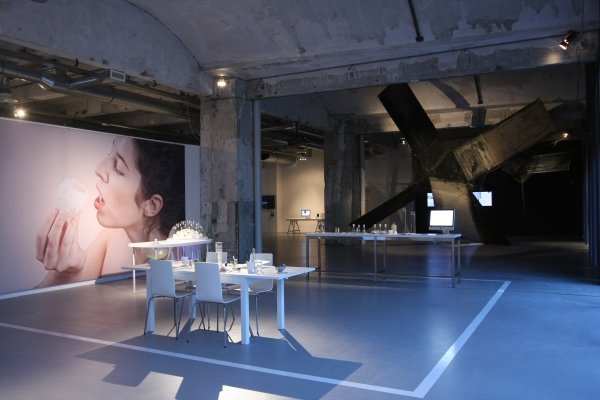For a town which, we would assume, boasts the highest density of designers in Europe, and which hosts one of the continent's more eclectic Design Weeks, Eindhoven in January is a very lonely place for the design devotee looking for an exhibition in which to wile away a spare afternoon.
Fortunately those exhibitions which are running "out of season" offer enough substance to keep you curious, questioning and satisfied for many a January to come, exhibitions such as Matter of Life. Growing new Bio Art & Design, currently showing at MU Gallery.

It may not be happening under the glare of popular publicity reserved for "sexier" aspects of design, but globally ever more artists and designers are turning their attention to biological systems; something which is as inevitable as it welcome. The future will, without question, see man making ever more interventions into, on and with living systems; not just in terms of genetic engineering to increase crop yields but also in terms of, for example, combating disease, improving energy efficiency, reducing resource usage and, we suspect and fear, "increasing personal security."
Currently such work is predominately carried out by scientists, and scientists work according to scientific principles and with scientific goals. However, if the technology that scientists develop is to be optimally applied it needs non-scientists to explore the practical nature of the associated problems and advantages, to develop useful presentation forms and consider possible extensions into other areas. Suitably trained designers are well placed to be those non-scientific experts.
Curated by author and art historian William Myers, Matter of Life. Growing new Bio Art & Design presents nine projects which in their own, individual, ways are all challenging the accepted borders between art, design and life sciences; and a collection of projects which when viewed together not only highlights the wide variety of work currently being undertaken, but also the challenges that lie ahead. Both technical and ethical.
Technical challenges such as those faced by, for example, the project Naval Gazing by Špela Petrič which is seeking to develop a robust yet simple platform which can be released into the sea and on which maritime fauna can grow, and thus allowing for resource light, globally accessible marine farming.
Ethical challenges such as those highlighted by, for example, "Invisible (The Future of Genetic Privacy)" by Heather Dewey-Hagborg which explores a future where we can "hide" our DNA as easily as our IP address and thus make ourselves genetically "invisible" and so untraceable and undefinable. But is that good? Always?
And projects which combine technical and ethical challenges such as, for example, "The Economics of Evolution: The Perfect Pigeon" from Studio PSK and the Centre for Ecological and Evolutionary Studies at the University of Groningen which predicts the use of specially bred pigeons as living databanks for storing and transporting commercially sensitive bio-technological and pharmaceutical information. Carrier pigeon is the pun we assume led to the choice of bird; but homing pigeons rarely fly into the wrong loft. Regardless how much bird seed the opposition may tempt them with.
In addition Matter of Life presents Common Flowers - Flower Commons by Shiho Fukuhara & Georg Tremmel, Fatberg by Mike Thompson and Arne Hendriks, A Simple Line by Jalila Essaïd, ‘Et in Arcadia Ego’ by Charlotte Jarvi and the absolutely delightful Fungi Mutarium, a project developed by Vienna based designers Julia Kaisinger and Katharina Unger in conjunction with the microbiology department of the University of Utrecht and which proposes transforming plastic waste into food with the help of microbes.
Which certainly sounds more favourable than the unpalatable, socially irresponsible fare currently being served to the rich and foolish under the guise of Cuisine.
What the exhibition sadly doesn't show is the ever monumental Spore Vase by Paulo Sellmayer, or the charmingly named follow-up "Dead". But then you can't have everything.
Essentially presenting artistic and design research much of what is on show appears at first sight as unnecessarily abstract, the sort of creative tomfoolery its all to easy to dismiss as youthful exuberance. But then at this point in time it can't be anything else, it is largely theoretical work. Hypothetical even.
In a few years however one or the other project could become reality, or at least have helped shape the path towards a new reality. Consequently, those of us who start considering the themes involved now will be the best placed to help ensure the future which ultimately arises is the one we really want.
Matter of Life. Growing new Bio Art & Design is an excellent place to start exploring.
Matter of Life. Growing new Bio Art & Design can be viewed at MU, Torenallee 40-06, Strijp S, 5617 Eindhoven until Sunday March 1st
Full details can be found at www.mu.nl